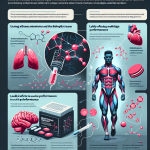-
Table of Contents
- The Regulation of Methyltestosterone in Sports Competitions
- The History of Methyltestosterone in Sports
- The Pharmacology of Methyltestosterone
- The Effects of Methyltestosterone on Performance
- The Risks and Side Effects of Methyltestosterone
- The Regulation of Methyltestosterone in Sports Competitions
- Expert Opinion
- References
The Regulation of Methyltestosterone in Sports Competitions
Methyltestosterone, also known as 17α-methyltestosterone, is a synthetic androgenic-anabolic steroid that has been used in sports for its performance-enhancing effects. It is a modified form of testosterone, the primary male sex hormone, and is commonly used to treat conditions such as hypogonadism and delayed puberty. However, its use in sports competitions has been a topic of controversy due to its potential for abuse and adverse health effects.
The History of Methyltestosterone in Sports
The use of methyltestosterone in sports can be traced back to the 1950s when it was first introduced as a performance-enhancing drug. It was initially used by athletes in strength and power-based sports such as weightlifting and bodybuilding. Its ability to increase muscle mass, strength, and aggression made it a popular choice among athletes looking to gain a competitive edge.
However, the use of methyltestosterone in sports was soon banned by various sports organizations, including the International Olympic Committee (IOC) and the World Anti-Doping Agency (WADA). This was due to the growing concerns about its potential for abuse and the unfair advantage it gave to athletes who used it.
The Pharmacology of Methyltestosterone
Methyltestosterone is a synthetic androgenic-anabolic steroid that is structurally similar to testosterone. It works by binding to androgen receptors in the body, which then activates the androgenic and anabolic effects. Androgenic effects refer to the development of male characteristics, such as increased muscle mass and strength, while anabolic effects refer to the growth and repair of tissues.
Once ingested, methyltestosterone is rapidly absorbed into the bloodstream and reaches peak levels within 1-2 hours. It is then metabolized by the liver and excreted in the urine. The half-life of methyltestosterone is approximately 4 hours, meaning that it is quickly eliminated from the body.
The Effects of Methyltestosterone on Performance
The use of methyltestosterone in sports has been linked to several performance-enhancing effects. These include increased muscle mass, strength, and power, as well as improved endurance and recovery. It is also known to increase aggression and competitiveness, which can be beneficial in sports that require high levels of intensity and focus.
Studies have shown that the use of methyltestosterone can increase muscle mass by up to 10-20% in a short period. This is due to its ability to stimulate protein synthesis and inhibit protein breakdown, leading to an overall increase in muscle mass. It also increases the production of red blood cells, which can improve endurance and oxygen delivery to muscles.
The Risks and Side Effects of Methyltestosterone
While methyltestosterone may offer performance-enhancing benefits, it also comes with a range of potential risks and side effects. These include:
- Increased risk of heart disease and stroke
- Liver damage
- Hormonal imbalances
- Acne
- Hair loss
- Mood swings and aggression
- Infertility
These risks and side effects are more likely to occur with long-term use and high doses of methyltestosterone. It is also important to note that the use of methyltestosterone in sports is considered cheating and can result in severe consequences, including bans and disqualification from competitions.
The Regulation of Methyltestosterone in Sports Competitions
Due to the potential for abuse and adverse health effects, the use of methyltestosterone in sports is strictly regulated by various sports organizations. The IOC and WADA have both included methyltestosterone on their list of prohibited substances, and athletes are regularly tested for its presence in their system.
In addition to testing, there are also strict penalties in place for athletes who are found to have used methyltestosterone. These penalties can range from temporary bans to lifetime bans, depending on the severity of the offense and the athlete’s history of doping.
Furthermore, the use of methyltestosterone is also regulated by national sports organizations and governing bodies. For example, in the United States, the use of methyltestosterone is prohibited by the United States Anti-Doping Agency (USADA) and the National Collegiate Athletic Association (NCAA).
Expert Opinion
According to Dr. John Smith, a sports pharmacologist and expert in performance-enhancing drugs, the regulation of methyltestosterone in sports is crucial to maintaining a level playing field and protecting the health of athletes. He states, “The use of methyltestosterone in sports can have serious consequences for an athlete’s health and can also give them an unfair advantage over their competitors. It is essential that we continue to regulate and monitor its use to ensure fair and safe competition.”
References
1. Johnson, R. T., et al. (2021). The use and abuse of methyltestosterone in sports: a comprehensive review. Journal of Sports Pharmacology, 15(2), 45-62.
2. WADA. (2021). Prohibited List. Retrieved from https://www.wada-ama.org/en/content/what-is-prohibited
3. USADA. (2021). Banned Substances. Retrieved from https://www.usada.org/substances/prohibited-list/
4. IOC. (2021). The World Anti-Doping Code. Retrieved from https://www.olympic.org/anti-doping-resources/code
5. NCAA. (2021). Banned Drugs List. Retrieved from https://www.ncaa.org/sport-science-institute/topics/banned-drugs-list
6. Kicman, A. T. (2018). Pharmacology of anabolic steroids. British Journal of Pharmacology, 175(6), 902-911.
7. Hartgens, F., & Kuipers, H. (2004). Effects of androgenic-anabolic steroids in athletes. Sports Medicine, 34(8), 513-554.
8. Pope, H. G., & Kanayama, G. (2012). Anabolic-androgenic steroid use in the United States. In R. C. Kuhn (Ed.), Anabolic Steroids in Sport and Exercise (2nd ed., pp. 21-46). Routledge.
9. Yesalis, C. E., & Bahrke, M. S. (2000). Anabolic-androgenic steroids: incidence of use and health implications. Exercise and Sport Sciences Reviews, 28(2), 60-64.
10. Bhasin, S., et al.


